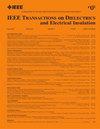湿热条件对硅橡胶电晕老化的影响
IF 2.9
3区 工程技术
Q2 ENGINEERING, ELECTRICAL & ELECTRONIC
IEEE Transactions on Dielectrics and Electrical Insulation
Pub Date : 2024-12-11
DOI:10.1109/TDEI.2024.3515916
引用次数: 0
摘要
本研究以高温硫化硅橡胶为样品,进行了湿热电晕老化试验。在不同的湿热条件下测试了硅橡胶的理化性能和电性能。结果表明,随着湿度或温度的升高,材料的表面结构被破坏,甚至粉碎。与原始样品相比,时效样品的静态接触角明显减小,并且由于粉化层中含有大量的小分子硅氧烷,呈现粉化的时效样品的静态接触角与未粉化样品相比扩大。老化硅橡胶的主链和侧链都有不同程度的损坏。由于硅氧烷中还含有Si-O-Si和Si-CH3键,因此在发生粉化的时效样品中,Si-O-Si和Si-CH3键的吸收峰高于未发生粉化的样品。老化的材料与大量极性基团结合,导致硅橡胶分子的极性增强,材料的介电损耗增加。时效试样在80℃时的表面电阻率和体积电阻率分别为原始试样的6.5%和70.3%和95%,说明电晕放电主要对材料表面造成损伤,而不是对材料内部造成损伤。本文章由计算机程序翻译,如有差异,请以英文原文为准。
Effects of Hygrothermal Conditions on Corona Aging of Silicone Rubber
In this research, high-temperature vulcanized silicone rubber is used as a sample to conduct a hygrothermal corona aging test. The physicochemical and electrical performance of the silicone rubber are tested under different hygrothermal conditions. The results show that the surface structure of the material is increasingly destroyed and even pulverized as humidity or temperature rises. Compared with the original samples, the static contact angle of the aged samples decreases significantly, and the static contact angle of the aged samples that exhibit pulverization expands compared with those unpulverized samples due to the large amount of small-molecule siloxanes contained in the pulverized layer. The main chain and side chain of the aged silicone rubber are damaged to varying degrees. The absorption peaks of Si–O–Si and Si–CH3 bonds in the aged samples that exhibit pulverization are higher than those of the samples that do not exhibit pulverization since the siloxane also contains Si–O–Si and Si–CH3 bonds. The aged material combines with a large number of polar groups, leading to an enhanced polarity of the silicone rubber molecules and more dielectric loss of the material. The surface resistivity and volume resistivity of the aged samples are 6.5% and 70.3% of those of the original samples at 80 °C and 95%, respectively, showing that corona discharge mainly damages the surface, rather than the interior of the material.
求助全文
通过发布文献求助,成功后即可免费获取论文全文。
去求助
来源期刊
CiteScore
6.00
自引率
22.60%
发文量
309
审稿时长
5.2 months
期刊介绍:
Topics that are concerned with dielectric phenomena and measurements, with development and characterization of gaseous, vacuum, liquid and solid electrical insulating materials and systems; and with utilization of these materials in circuits and systems under condition of use.

 求助内容:
求助内容: 应助结果提醒方式:
应助结果提醒方式:


